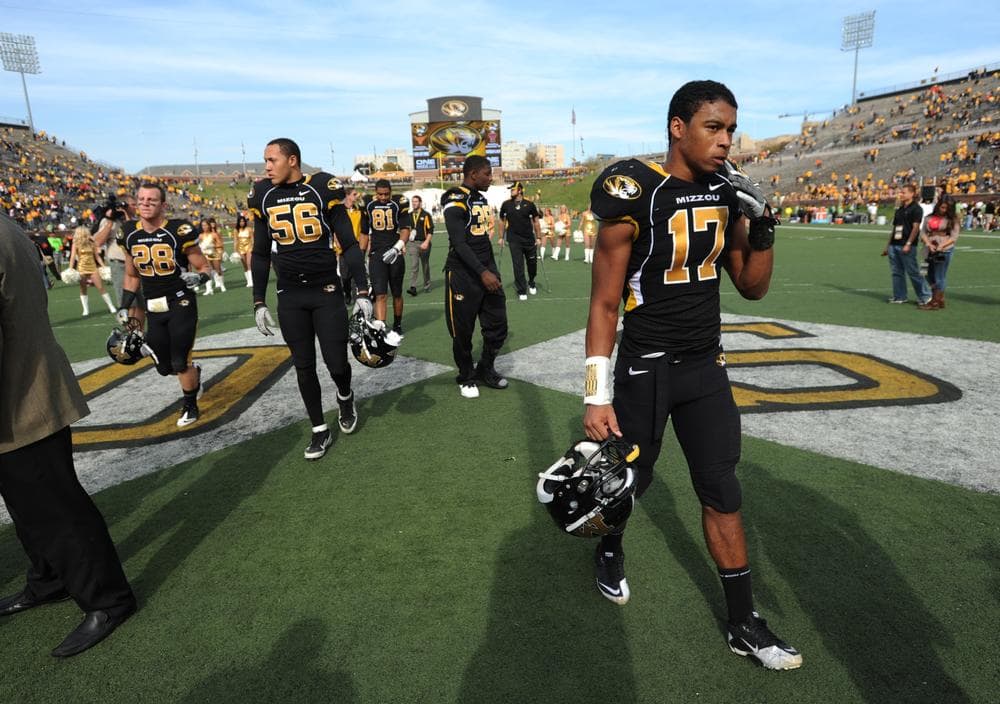Advertisement
NCAA Conference Realignment
Resume
The University of Missouri is in the Midwest, but for the past few weeks university presidents, athletic conference officials, TV executives, US Senators, and college football fans from the South, North, West, and East have had their eyes on the Tigers.
That's because Missouri is expected to leave the Big 12 to join the Southeastern Conference, a move that has already begun to impact a number other conferences.
How did the Tigers end up in the catbird seat? This fall Texas A&M left the Big 12 for the Southeastern Conference. That gave the SEC an uneven 13 members, which can cause scheduling difficulties. Enter Missouri.
The SEC prematurely welcomed the Tigers in a post on its website Thursday night, but quickly pulled the piece saying there was no agreement. The Big 12 got tired of waiting and on Friday extended an invitation to West Virginia. The Mountaineers gladly accepted. Fellow Big East member Louisville had been vying for the slot, too.
In fact, the Big 12 opening was so desirable that, as Pete Thamel first reported in the New York Times, Senate Minority Leader Mitch McConnell of Kentucky contacted officials at two Big 12 schools to lobby for Louisville’s admission.
“How much influence Mitch McConnell had in slowing down this West Virginia train and giving Louisville a shot, I don’t know and I don’t know if we’ll ever know," Thamel told Only A Game. "We do know he did have influence and he did make calls and people in West Virginia are irate.”
“The one constant factor here is money. Other than that, there’ve been a lot of different reasons, agendas, but at the end of the day, these school presidents are chasing the almighty dollar."
Pete Thamel, New York Times
“As anxious as everyone, including our rabid fan base, is to have a definitive answer, we have to exercise our fiduciary duty, " Erdman said. "We are taking our time to analyze all of the issues and to exercise that fiduciary duty on behalf of the university.”
It’s no coincidence that Erdman mentions “fiduciary duty” twice. Thamel says Missouri and every other school considering a move are driven by the same thing.
“The one constant factor here is money. Other than that, there've been a lot of different reasons, agendas, but at the end of the day, these school presidents are chasing the almighty dollar. And as the market has continued to grow, and schools have tried to look out for their own best interests, it’s created this whole chaotic landscape.”
In July, the Pacific-10 Conference – or Pac-10 - became the Pac-12 shortly after adding the universities of Colorado and Utah to its ranks. How the teams will affect the athletic competition remains to be seen, but their impact on the Pac-12’s finances was almost immediate.
The conference brokered a new 12-year television agreement with Fox and ESPN worth a total of $3 billion, yes, billion dollars.
Neil Pilson spent nearly two decades with CBS Sports, twice serving as president. Today he heads Pilson Communications, a sports television consulting firm.
“It isn’t so much the amount of television money, it is the security of television money. What’s happening now is deals are being made for a much longer term than in the past,” Pilson said. “20 years ago a long-term deal might be 3 to 5 years. Now we’re talking about 8, 10, 12, even 14-year deals.”
According to Pilson, college football also provides a low-risk, high-reward investment for television networks.
“Not only is it stable and safe, it’s growing,” Pilson said. “College football today and projected 10, 20, 30 years down the road is a very secure franchise.”
You might be saying, “OK, enough about money - what about rivalries?”
Jon Wilner, a college sports writer for the San Jose Mercury News, says some key matchups could be lost in the shuffle.
“<strong>“</strong>Is it really worth traveling across the country every other week to be in a football league? I think 5 or 10 years from now we’ll look back on this time and think, ‘What in the world happened to college athletics?’”
Brett McMurphy, CBSSports.com
West Virginia versus Pittsburgh is another rivalry that dates back more than 100 years. The Panthers have already agreed to leave the Big East for the Atlantic Coast Conference. With the Mountaineers off to the Big 12, the game known as “The Backyard Brawl” could be discontinued unless it’s scheduled as a non-conference matchup.
"OK," you say. "New rivalries can develop, but what about geography?"
With Syracuse and Pitt already headed for the ACC, the Big East is considering the addition of Moutain West members Air Force and Boise State, and not-exactly-eastern programs including Brigham Young University, the University of Houston, and Southern Methodist University.
CBSSports.com Senior Writer Brett McMurphy believes stretching the conferences beyond their traditional borders will hurt the product.
“Is it really worth traveling across the country every other week to be in a football league? I think 5 or 10 years from now we’ll look back on this time and think, ‘What in the world happened to college athletics?’” McMurphy said. “And more specifically, how cool it was when schools actually were competing against teams in neighboring states and didn’t fly all over the country. Basically they’re turning into a version of the NFL.”
At this point you might find yourself wondering … what about basketball?
McMurphy says conference realignment affects basketball, but, as Kansas learned, the moves are all about football.
“When it appeared that the Big 12 was going to implode and the schools were going to leave for the Pac-12, Kansas was one of the schools that was [going to be] left without a conference home,” McMurphy said. “Kansas has arguably the greatest basketball tradition in the history of the country. Yet no conference wanted them.”
One key difference between football and basketball is money. Universities can negotiate their own agreements and profit directly from TV and bowl game contracts. And there are six conferences guaranteed a Bowl Championship Series bid, which ups their value to TV networks and makes them more attractive to universities. But in basketball the NCAA collects the TV money from March Madness and distributes it to the schools.
The impact of conference realignment extends well beyond the gridiron and the hardwood. Athletes in other sports like track and field may not generate big revenues, but they’re affected.
“Just because a change in conference is good for the football program doesn’t mean it’s good for all the Olympic sports,” said John Wilner. “But the schools believe in order to pay for scholarships in the Olympic sports, pay for competitive coaching salaries in the Olympic sports, they have got to chase the football money, so that’s what is driving everything.”
It’s not like change is something new for major college sports. Conferences come and go. Tournaments expand. Bowl games get longer – and funnier - names. A complex formula decides who plays for the national championship.
But one thing is constant: students and alums will root for their alma maters in any conference.
This segment aired on October 29, 2011.
